by Jason Bodner
October 29, 2024
In 1975, China’s Banqiao Dam failure was catastrophic. Along with 61 other dams, Banqiao collapsed when Typhoon Nina hit China, causing the third deadliest flood in history. It killed as many as 240,000 people, affected 10.1 million, and collapsed 6.8 million homes.
This disaster could have been prevented. Cracks were observed in the dam shortly after its construction in 1952, early in Mao’s rule, but nobody wanted to criticize the builders – or the central government.
Sometimes cracks appear in the stock market, too. Well, one just did… our trusted BMI has just fallen from overbought, just a few days after it turned overbought.
Today, I’ll look at just what this means, what to expect and, most importantly, how to play it.
Below, we see that the BMI poked its head above overbought (80), then quickly retreated back below:
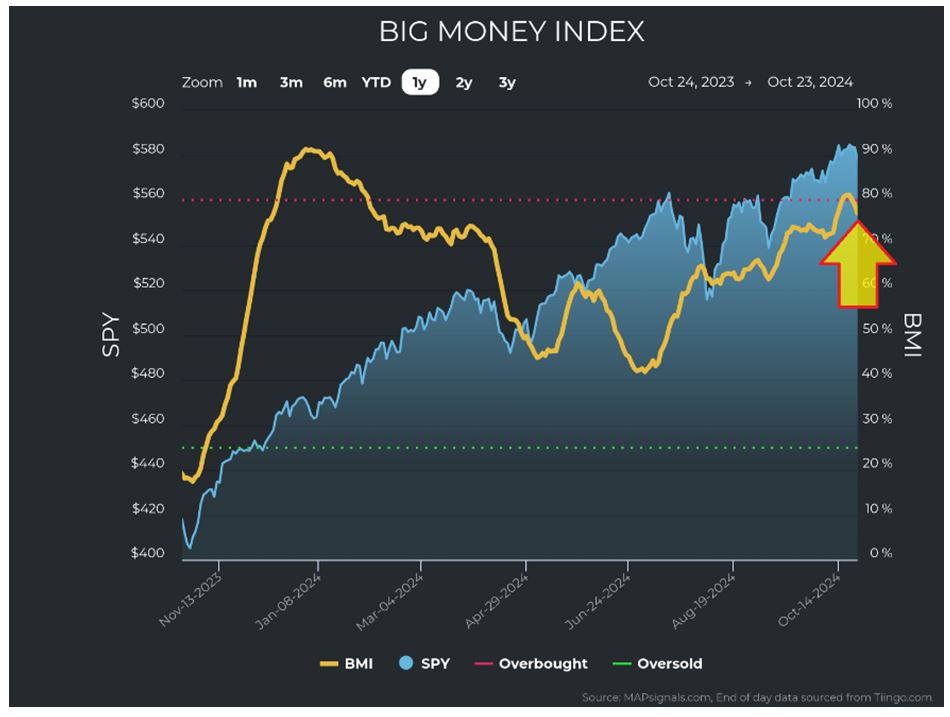
Graphs are for illustrative and discussion purposes only. Please read important disclosures at the end of this commentary.
Prior to this occurrence, the average duration of an overbought market was 22 days, based on the previous 73 times it happened – and the forward returns from the first day overbought were quite positive:

Graphs are for illustrative and discussion purposes only. Please read important disclosures at the end of this commentary.
This time, however, the BMI was above the 80% overbought threshold for only four days. This isn’t that uncommon: Historically, 20% of the overbought instances were four days or less in duration.
As a data scientist and quantitative analyst, I choose to err on the side of caution and go with the averages. That means, when the BMI falls from overbought, historically it means that a weaker market is ahead.
In fact, one of our studies shows that since 2014, each time the BMI falls from overbought we see that weaker markets follow:
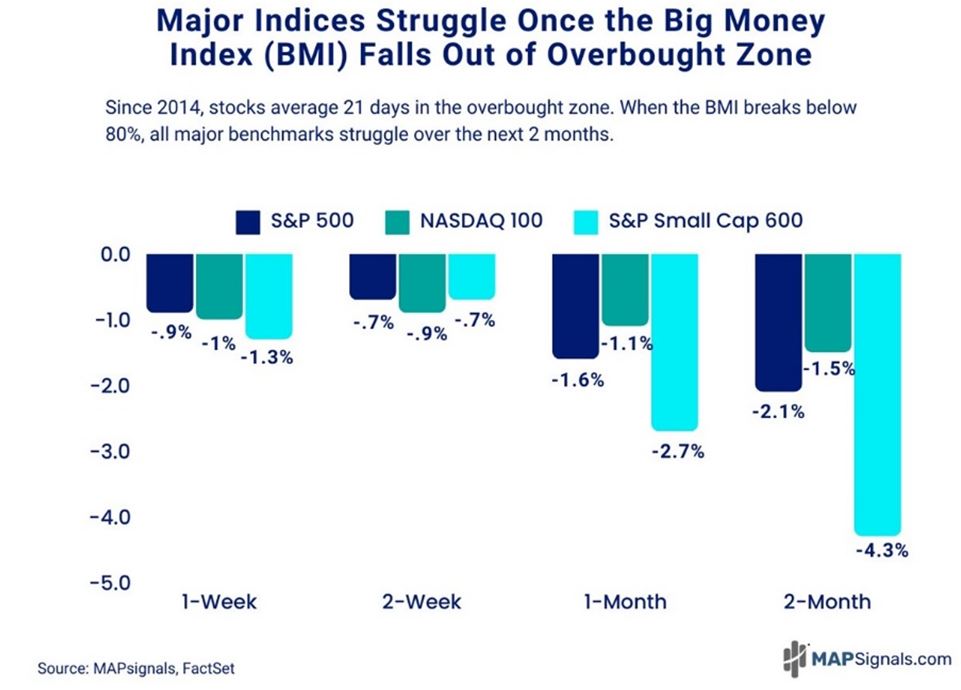
Graphs are for illustrative and discussion purposes only. Please read important disclosures at the end of this commentary.
Now that we’ve established that fact, should we sell stocks?
Well, I am not selling anything. If anything, I will be looking for dips as buying opportunities.
Let’s just dig below the surface of the BMI for a moment. One thing to note is that the BMI hasn’t fallen due to a seismic increase in unusually large selling. In fact, it’s the sudden sharp fall-off from unusually large buying that is tanking the number:
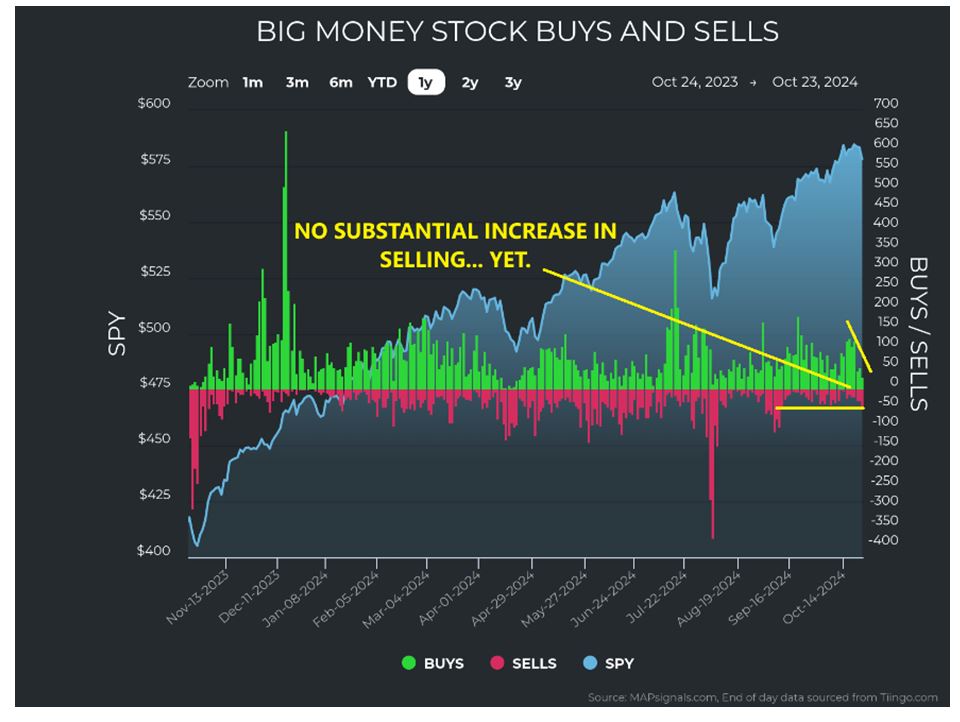
Graphs are for illustrative and discussion purposes only. Please read important disclosures at the end of this commentary.
If the BMI were plummeting along with a huge spike in selling, I’d be more concerned.
It’s also important to understand that a BMI falling from overbought doesn’t always mean the indexes will drop. Take for instance, in February of this year when the BMI fell from overbought.
As you can see in this chart, the BMI fell but the index kept on rallying for months:
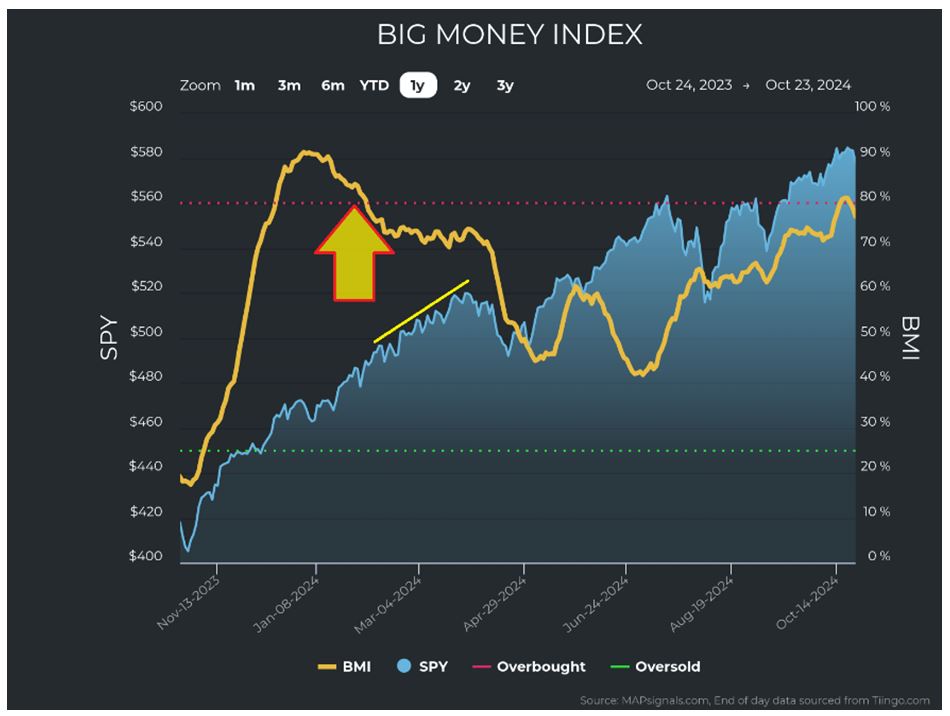
Graphs are for illustrative and discussion purposes only. Please read important disclosures at the end of this commentary.
Here’s the rub: Stock investors don’t always just buy the index and passively ride along with the overall market. In fact, an active stock picker, like myself, will remember that for years the market kept running higher on the power of the Magnificent-7, while the other 493 stocks in the S&P 500 struggled.
I’m not saying that will be the case this time, but it’s something to remember.
There is still time for an October surprise, and some election volatility. If we see softness in the final few days of October and the few days leading up to election, that would fit the historical playbook of the BMI weakening going into elections. In fact, this year was set to buck the election trend… that is, until October 22nd. Notice how the yellow line (BMI) falls before the election (blue vertical line) most election years:
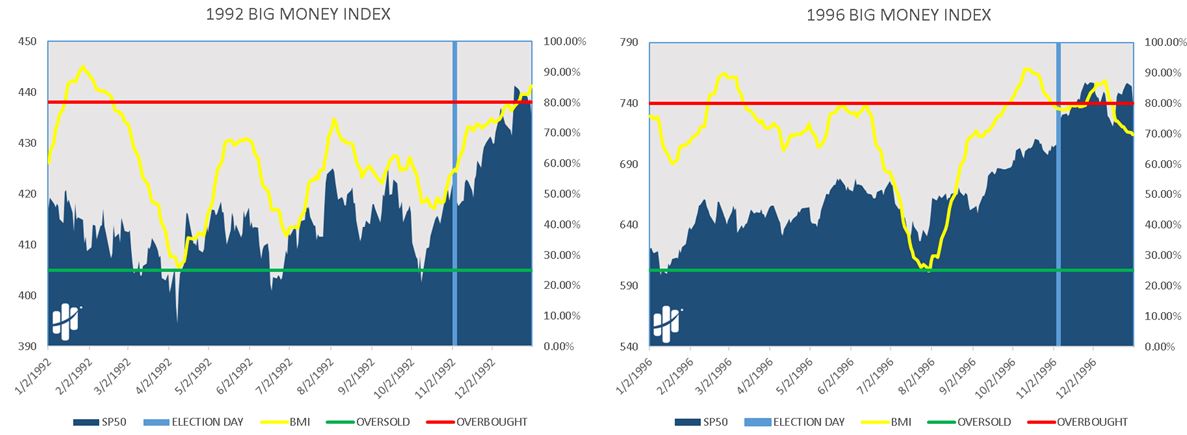
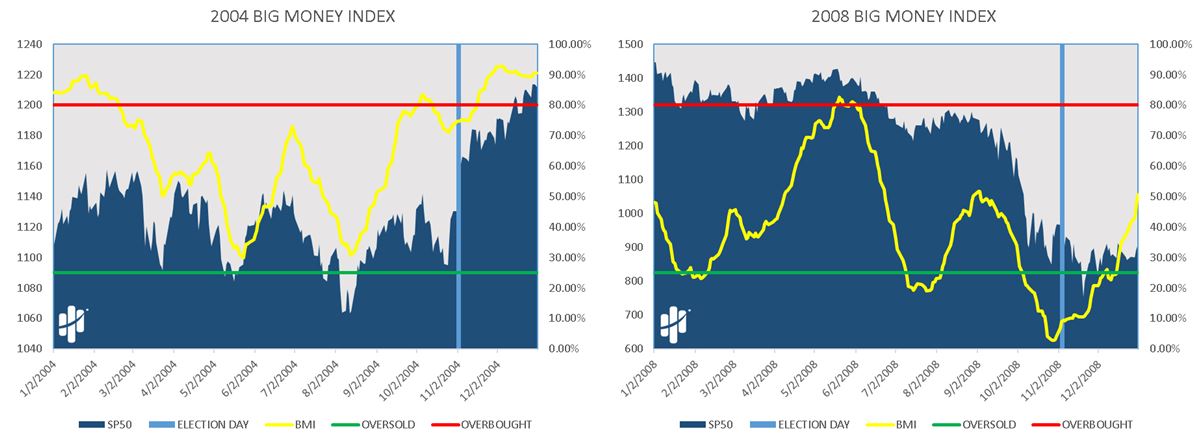
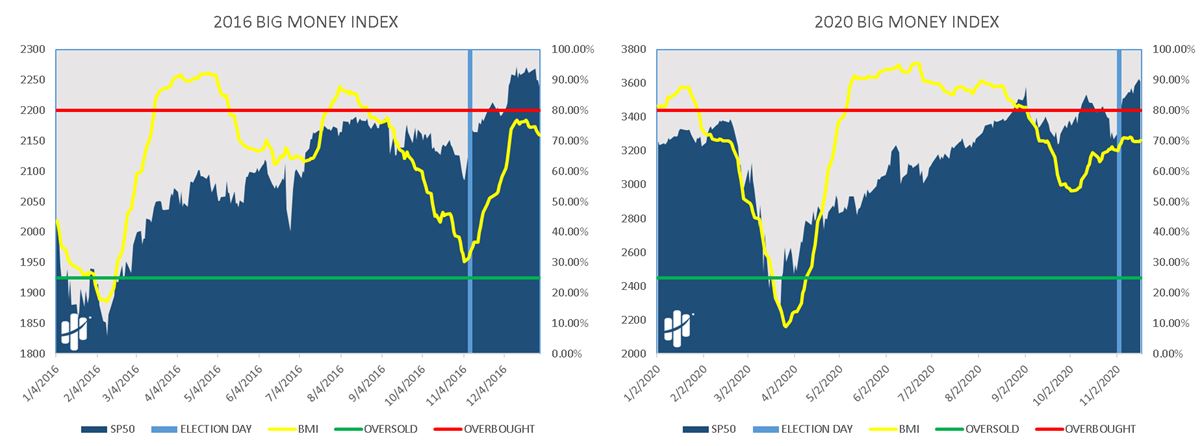
Graphs are for illustrative and discussion purposes only. Please read important disclosures at the end of this commentary.
Well, if stocks might be set to swoon soon, how come I’m not selling? First and foremost, the seasonality factor is on our side. Novembers are by far the strongest months of the year, going back to 1990:

Graphs are for illustrative and discussion purposes only. Please read important disclosures at the end of this commentary.
Better yet, Novembers are positive 73.5% of the time since 1990:

Graphs are for illustrative and discussion purposes only. Please read important disclosures at the end of this commentary.
Second, rates are set to continue falling throughout the rest of the year and through 2025.
There is now a bitter debate in the markets about whether that pace will be as strong or often as previously thought. We can see that in the 10-year Treasury rallied nearly 17% from September 16th:
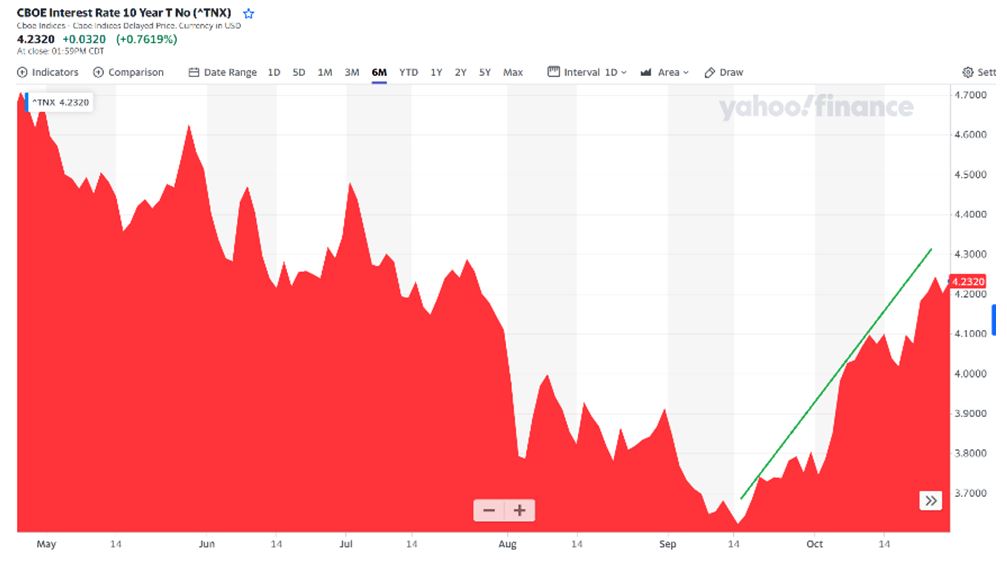
Graphs are for illustrative and discussion purposes only. Please read important disclosures at the end of this commentary.
We should get clarity on the near-term path for rates soon, but in the long term they are assured to fall. This is great for stocks, especially small and mid-caps.
I think a more interesting approach is to ask: How should I play any coming volatility?
The answer really starts with answering another question: How do you pick stocks in your portfolio?
If the answer is by identifying companies with solid sales and earnings growth, expanding profit margins, with manageable debt levels seeing heavy accumulation; well then, you’re on the right track.
The way to play it is by identifying opportunities.
We find opportunities by first checking on sector strengths and weakness.
The first thing we notice is individual sectors that aren’t seeing much selling:

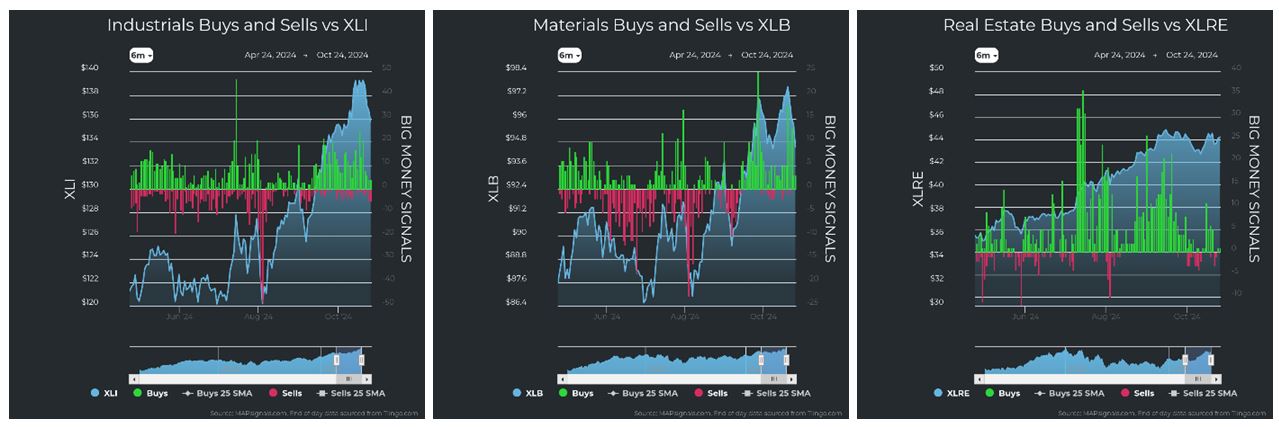

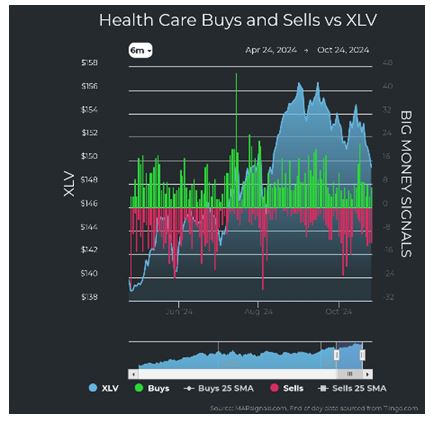
Graphs are for illustrative and discussion purposes only. Please read important disclosures at the end of this commentary.
Usually, a market starts to break down when it is led by one or a couple of sectors. I’m just not seeing that in the data. In fact, I am seeing some sectors just naturally retreating from recent huge rises. Such is the case with Financials, Technology, Industrials, Materials, Real Estate, and Health Care.
Checking in on the rankings, we see Health Care is dead last:
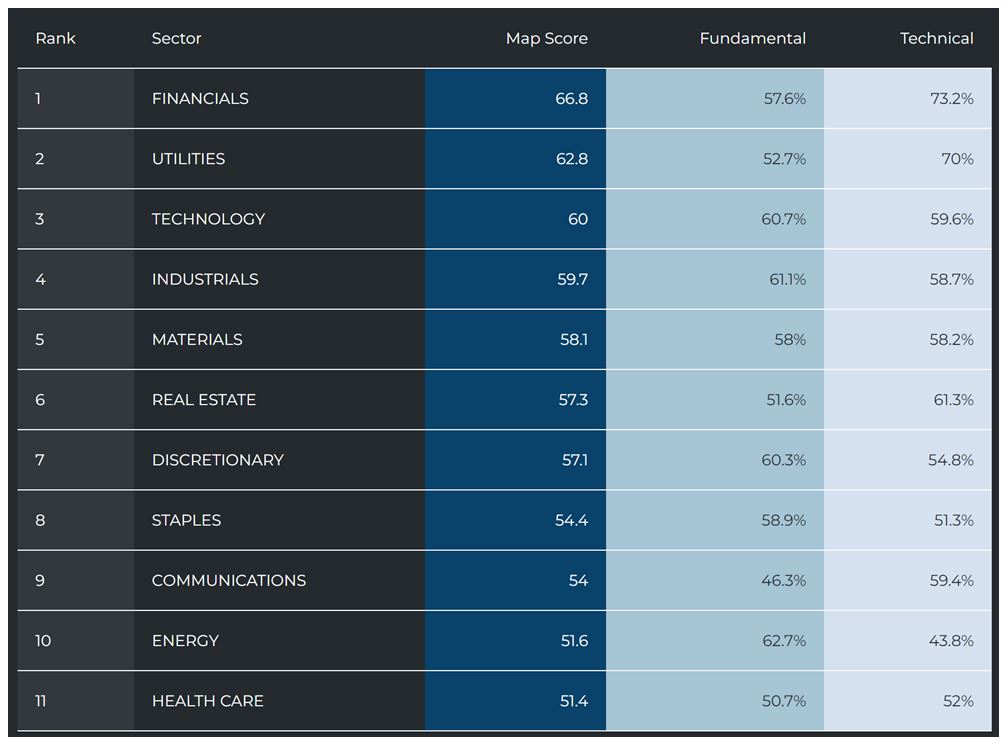
Graphs are for illustrative and discussion purposes only. Please read important disclosures at the end of this commentary.
But that might be where to find some opportunity. Ordinarily, I like to use the old axiom: the trend is your friend. Using that logic, we should look in Financials, Utilities, and Technology. But let’s imagine you could only trade Health stocks to find bargains. The seemingly endless push and pull of buyers versus sellers in the sector makes for a confusing landscape:
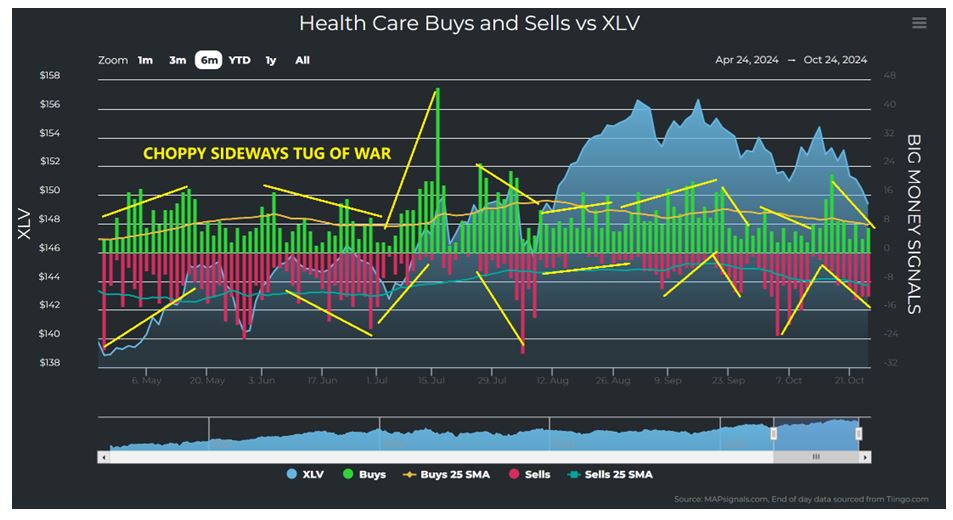
Graphs are for illustrative and discussion purposes only. Please read important disclosures at the end of this commentary.
My plan would be to identify the top and bottom stocks with a ranking system. This way we can discern the leaders, and the laggards to avoid. The fact is I can find buys in this sector, too. The bottom line is that regardless of the market direction or outcome, we can identify winners and losers within any set of stocks.
The BMI is falling from overbought. Volatility may be near. Or it may not. Either way, we can choose to flee or face opportunity. Or, as Seneca put it, “Luck is where opportunity meets preparation.”
All content above represents the opinion of Jason Bodner of Navellier & Associates, Inc.
Also In This Issue
A Look Ahead by Louis Navellier
The Election (and the World After) Start to Come Clear
Income Mail by Bryan Perry
The Timely Allure of Tax-Free Bonds
Growth Mail by Gary Alexander
Welcome to Transition Week – NOVEMBER, Here We Come!
Global Mail by Ivan Martchev
Have Stocks (Finally) Begun to Notice Bonds?
Sector Spotlight by Jason Bodner
Are We Seeing “Cracks” in This Bull Market?
View Full Archive
Read Past Issues Here

Jason Bodner
MARKETMAIL EDITOR FOR SECTOR SPOTLIGHT
Jason Bodner writes Sector Spotlight in the weekly Marketmail publication and has authored several white papers for the company. He is also Co-Founder of Macro Analytics for Professionals which produces proprietary equity accumulation and distribution research for its clients. Previously, Mr. Bodner served as Director of European Equity Derivatives for Cantor Fitzgerald Europe in London, then moved to the role of Head of Equity Derivatives North America for the same company in New York. He also served as S.V.P. Equity Derivatives for Jefferies, LLC. He received a B.S. in business administration in 1996, with honors, from Skidmore College as a member of the Periclean Honors Society. All content of “Sector Spotlight” represents the opinion of Jason Bodner
Important Disclosures:
Jason Bodner is a co-founder and co-owner of Mapsignals. Mr. Bodner is an independent contractor who is occasionally hired by Navellier & Associates to write an article and or provide opinions for possible use in articles that appear in Navellier & Associates weekly Market Mail. Mr. Bodner is not employed or affiliated with Louis Navellier, Navellier & Associates, Inc., or any other Navellier owned entity. The opinions and statements made here are those of Mr. Bodner and not necessarily those of any other persons or entities. This is not an endorsement, or solicitation or testimonial or investment advice regarding the BMI Index or any statements or recommendations or analysis in the article or the BMI Index or Mapsignals or its products or strategies.
Although information in these reports has been obtained from and is based upon sources that Navellier believes to be reliable, Navellier does not guarantee its accuracy and it may be incomplete or condensed. All opinions and estimates constitute Navellier’s judgment as of the date the report was created and are subject to change without notice. These reports are for informational purposes only and are not a solicitation for the purchase or sale of a security. Any decision to purchase securities mentioned in these reports must take into account existing public information on such securities or any registered prospectus.To the extent permitted by law, neither Navellier & Associates, Inc., nor any of its affiliates, agents, or service providers assumes any liability or responsibility nor owes any duty of care for any consequences of any person acting or refraining to act in reliance on the information contained in this communication or for any decision based on it.
Past performance is no indication of future results. Investment in securities involves significant risk and has the potential for partial or complete loss of funds invested. It should not be assumed that any securities recommendations made by Navellier. in the future will be profitable or equal the performance of securities made in this report. Dividend payments are not guaranteed. The amount of a dividend payment, if any, can vary over time and issuers may reduce dividends paid on securities in the event of a recession or adverse event affecting a specific industry or issuer.
None of the stock information, data, and company information presented herein constitutes a recommendation by Navellier or a solicitation to buy or sell any securities. Any specific securities identified and described do not represent all of the securities purchased, sold, or recommended for advisory clients. The holdings identified do not represent all of the securities purchased, sold, or recommended for advisory clients and the reader should not assume that investments in the securities identified and discussed were or will be profitable.
Information presented is general information that does not take into account your individual circumstances, financial situation, or needs, nor does it present a personalized recommendation to you. Individual stocks presented may not be suitable for every investor. Investment in securities involves significant risk and has the potential for partial or complete loss of funds invested. Investment in fixed income securities has the potential for the investment return and principal value of an investment to fluctuate so that an investor’s holdings, when redeemed, may be worth less than their original cost.
One cannot invest directly in an index. Index is unmanaged and index performance does not reflect deduction of fees, expenses, or taxes. Presentation of Index data does not reflect a belief by Navellier that any stock index constitutes an investment alternative to any Navellier equity strategy or is necessarily comparable to such strategies. Among the most important differences between the Indices and Navellier strategies are that the Navellier equity strategies may (1) incur material management fees, (2) concentrate its investments in relatively few stocks, industries, or sectors, (3) have significantly greater trading activity and related costs, and (4) be significantly more or less volatile than the Indices.
ETF Risk: We may invest in exchange traded funds (“ETFs”) and some of our investment strategies are generally fully invested in ETFs. Like traditional mutual funds, ETFs charge asset-based fees, but they generally do not charge initial sales charges or redemption fees and investors typically pay only customary brokerage fees to buy and sell ETF shares. The fees and costs charged by ETFs held in client accounts will not be deducted from the compensation the client pays Navellier. ETF prices can fluctuate up or down, and a client account could lose money investing in an ETF if the prices of the securities owned by the ETF go down. ETFs are subject to additional risks:
- ETF shares may trade above or below their net asset value;
- An active trading market for an ETF’s shares may not develop or be maintained;
- The value of an ETF may be more volatile than the underlying portfolio of securities the ETF is designed to track;
- The cost of owning shares of the ETF may exceed those a client would incur by directly investing in the underlying securities and;
- Trading of an ETF’s shares may be halted if the listing exchange’s officials deem it appropriate, the shares are delisted from the exchange, or the activation of market-wide “circuit breakers” (which are tied to large decreases in stock prices) halts stock trading generally.
Grader Disclosures: Investment in equity strategies involves substantial risk and has the potential for partial or complete loss of funds invested. The sample portfolio and any accompanying charts are for informational purposes only and are not to be construed as a solicitation to buy or sell any financial instrument and should not be relied upon as the sole factor in an investment making decision. As a matter of normal and important disclosures to you, as a potential investor, please consider the following: The performance presented is not based on any actual securities trading, portfolio, or accounts, and the reported performance of the A, B, C, D, and F portfolios (collectively the “model portfolios”) should be considered mere “paper” or pro forma performance results based on Navellier’s research.
Investors evaluating any of Navellier & Associates, Inc.’s, (or its affiliates’) Investment Products must not use any information presented here, including the performance figures of the model portfolios, in their evaluation of any Navellier Investment Products. Navellier Investment Products include the firm’s mutual funds and managed accounts. The model portfolios, charts, and other information presented do not represent actual funded trades and are not actual funded portfolios. There are material differences between Navellier Investment Products’ portfolios and the model portfolios, research, and performance figures presented here. The model portfolios and the research results (1) may contain stocks or ETFs that are illiquid and difficult to trade; (2) may contain stock or ETF holdings materially different from actual funded Navellier Investment Product portfolios; (3) include the reinvestment of all dividends and other earnings, estimated trading costs, commissions, or management fees; and, (4) may not reflect prices obtained in an actual funded Navellier Investment Product portfolio. For these and other reasons, the reported performances of model portfolios do not reflect the performance results of Navellier’s actually funded and traded Investment Products. In most cases, Navellier’s Investment Products have materially lower performance results than the performances of the model portfolios presented.
This report contains statements that are, or may be considered to be, forward-looking statements. All statements that are not historical facts, including statements about our beliefs or expectations, are “forward-looking statements” within the meaning of The U.S. Private Securities Litigation Reform Act of 1995. These statements may be identified by such forward-looking terminology as “expect,” “estimate,” “plan,” “intend,” “believe,” “anticipate,” “may,” “will,” “should,” “could,” “continue,” “project,” or similar statements or variations of such terms. Our forward-looking statements are based on a series of expectations, assumptions, and projections, are not guarantees of future results or performance, and involve substantial risks and uncertainty as described in Form ADV Part 2A of our filing with the Securities and Exchange Commission (SEC), which is available at www.adviserinfo.sec.gov or by requesting a copy by emailing info@navellier.com. All of our forward-looking statements are as of the date of this report only. We can give no assurance that such expectations or forward-looking statements will prove to be correct. Actual results may differ materially. You are urged to carefully consider all such factors.
FEDERAL TAX ADVICE DISCLAIMER: As required by U.S. Treasury Regulations, you are informed that, to the extent this presentation includes any federal tax advice, the presentation is not written by Navellier to be used, and cannot be used, for the purpose of avoiding federal tax penalties. Navellier does not advise on any income tax requirements or issues. Use of any information presented by Navellier is for general information only and does not represent tax advice either express or implied. You are encouraged to seek professional tax advice for income tax questions and assistance.
IMPORTANT NEWSLETTER DISCLOSURE:The hypothetical performance results for investment newsletters that are authored or edited by Louis Navellier, including Louis Navellier’s Growth Investor, Louis Navellier’s Breakthrough Stocks, Louis Navellier’s Accelerated Profits, and Louis Navellier’s Platinum Club, are not based on any actual securities trading, portfolio, or accounts, and the newsletters’ reported hypothetical performances should be considered mere “paper” or proforma hypothetical performance results and are not actual performance of real world trades. Navellier & Associates, Inc. does not have any relation to or affiliation with the owner of these newsletters. There are material differences between Navellier Investment Products’ portfolios and the InvestorPlace Media, LLC newsletter portfolios authored by Louis Navellier. The InvestorPlace Media, LLC newsletters contain hypothetical performance that do not include transaction costs, advisory fees, or other fees a client might incur if actual investments and trades were being made by an investor. As a result, newsletter performance should not be used to evaluate Navellier Investment services which are separate and different from the newsletters. The owner of the newsletters is InvestorPlace Media, LLC and any questions concerning the newsletters, including any newsletter advertising or hypothetical Newsletter performance claims, (which are calculated solely by Investor Place Media and not Navellier) should be referred to InvestorPlace Media, LLC at (800) 718-8289.
Please note that Navellier & Associates and the Navellier Private Client Group are managed completely independent of the newsletters owned and published by InvestorPlace Media, LLC and written and edited by Louis Navellier, and investment performance of the newsletters should in no way be considered indicative of potential future investment performance for any Navellier & Associates separately managed account portfolio. Potential investors should consult with their financial advisor before investing in any Navellier Investment Product.
Navellier claims compliance with Global Investment Performance Standards (GIPS). To receive a complete list and descriptions of Navellier’s composites and/or a presentation that adheres to the GIPS standards, please contact Navellier or click here. It should not be assumed that any securities recommendations made by Navellier & Associates, Inc. in the future will be profitable or equal the performance of securities made in this report.
FactSet Disclosure: Navellier does not independently calculate the statistical information included in the attached report. The calculation and the information are provided by FactSet, a company not related to Navellier. Although information contained in the report has been obtained from FactSet and is based on sources Navellier believes to be reliable, Navellier does not guarantee its accuracy, and it may be incomplete or condensed. The report and the related FactSet sourced information are provided on an “as is” basis. The user assumes the entire risk of any use made of this information. Investors should consider the report as only a single factor in making their investment decision. The report is for informational purposes only and is not intended as an offer or solicitation for the purchase or sale of a security. FactSet sourced information is the exclusive property of FactSet. Without prior written permission of FactSet, this information may not be reproduced, disseminated or used to create any financial products. All indices are unmanaged and performance of the indices include reinvestment of dividends and interest income, unless otherwise noted, are not illustrative of any particular investment and an investment cannot be made in any index. Past performance is no guarantee of future results.
